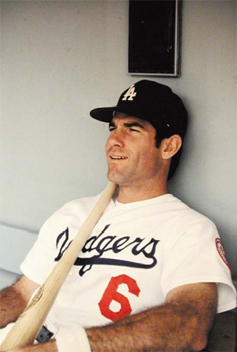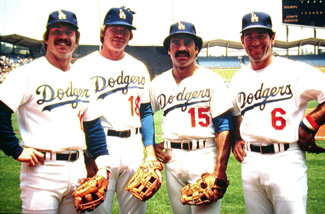Published In C&K Magazine: Vol. #1 – Issue #1 – Date: 2006
Dodger organization of the late 1970s and early 1980s was thought by many to be best in baseball. One thing is for sure, they won and did it often. Steve Garvey was one of the staples. It was my pleasure to speak with Steve pertaining to success after baseball.

C&K: As we speak, the baseball season is under way, does that cause you to get the bug? Do you miss it at all?
SG: Well it’s funny, the first couple years that you’re out of baseball, like the middle of February, your body starts craving the working out element, and then by the third or forth year you’ve changed your direction in life, your on a new path. In my case I’d already started the Garvey Marketing Group. Basically catering to 12-15 clients I had cultivated over the years like McDonald’s, Pepsi Cola, Delta Airlines and Adidas. Even though we were small, we were a very effective company and it laid the groundwork for getting kind of a Bachelor of Science in business while I was still playing.
C&K: Part of your businesses interests now includes speaking engagements, are these primarily motivational endeavors?
SG: I think so. Some people will say, “Hey, it’s March, why don’t you just tell us stories and talk about the state of sports?” which was fun for me. Everybody wants to know about steroids and if Pete Rose should be in the Hall of Fame. They want to know why I’m not in the Hall of Fame myself. How could players be making $15 million a year playing a sport? Yeah, I no longer can get up in the bottom of the ninth with the bases loaded, 2 out, down a run, and in front of 50,000 people get a hit and win the game. But if I can get up in front of a group and feel that I’ve somehow, some way affected them or influenced them, then that’s my home run.
C&K: You’d mentioned that everyone wants to hear about steroids. When you played, if I recall correctly, coaches didn’t really want you touching a weight. They all were afraid of people getting muscle bound, which would affect their swing or inhibit a pitching arm. What do you feel about testing of players now and what’s going on?
SG: Well, I think it’s been an evolution of the need to be bigger, stronger and faster. The evolution of steroids in football started back in the 80s. The big linemen needing to get bigger and bigger to compete …that transferred into track & field and then baseball. When I first came up in the 60s and early 70s, I was a football player, so I lifted anyway. I thought that was important. People are always going to find ways to cheat. In the 70s and 80s it was amphetamines. Guys using drugs to get themselves up for the game and try to enhance their performance and that transitioned into the real elite performance enhancing drugs like the Andro, and the Creatine, THG and all that. It falls under the category of shortcut to success and when I talk to people I tell them, there is no shortcut to success. There may be a short-term enhancement but it is going to cut off a sizeable portion of the backend of an individual’s career. It affects the liver, kidneys, joints and all of a sudden, within a couple of years you’re gone.
C&K: Do you find that the discipline and tools that you used to play more than 162 games a year, translates easily into business success?
SG: I think the fundamental virtues of success cover the basis of sport, business and entertainment. I kind of call it my diamond theory of success. First, develop a strong interest in what you are doing. Second, make a total commitment if you want to be successful. Third, use all the resources that can educate you… so that you can have an A to Z understanding of the business. Forth, which I think is very, very important is… you need to be entrepreneurial. It’s the entrepreneur that comes up with ideas or a product or whatever and becomes successful with it.

C&K: If I recall correctly you were drafted in 1968 by the Dodgers. That was a tremendous draft; there was Bill Buckner, Bobby Valentine, Joe Ferguson and Ron Cey. What was your first spring training like?
SG: Our first spring training was very interesting for me because back in 1956, growing up in Tampa Florida, my father drove a bus for Greyhound. About the middle of March in 1956 he came home on Thursday evening asked “Do you want to skip school tomorrow? Well, I have a charter to pick up the Brooklyn Dodgers from Tampa International Airport and take them to St. Petersburg to play the New York Yankees in an exhibition game.” I said, “Wow, yeah, do you think I could be a bat boy?” and he said, “We’ll see. I hope so.” The irony is this was the spring after the great 1955 Fall Classic where the Dodgers finally beat the Yankees. So, this was the world champion Brooklyn Dodgers. The next day, I got my Vanlon T-shirt out and my flat top and we picked up the bus and drove through the tarmac of Tampa International Airport, The Kay O’Malley 1 landed, which was a DC-7 prop jet. They were the only team in baseball that had a plane. It taxied up and they pushed the stairs up and off came Walter Alston, Pee Wee Reese, Gil Hodges and Roy Campanella and Jackie Robinson, you know, the boys of summer. So that day I fell in love with baseball, and I was the batboy. I picked up all the bats and balls; got a couple of autographed ones, a couple of broken bats and you know the rest is really a Hollywood script. Twelve years later I become a first round draft choice for the Dodgers, played 15 years for them, and went to four World Series, I went to 10 All-star games and I ended up playing first base like my idol Gil Hodges.
C&K: When you were drafted as a first round draft choice, did you have any doubt that you would make the big-league roster?
SG: No. You grow up as a kid and everybody has different dreams and goals and mine was to be a professional baseball player, especially a Dodger. So when I was drafted by the Dodgers I figured I got double destiny there. And I had power, which the Dodgers didn’t have at that time. You know they had a lot of pitching but no power. I won the 3rd base position in the spring of 1970 and did a Vitalis commercial. The first couple of years I struggled as a wild armed 3rd baseman. On July 23, 1973, I was leading the league in pinch hitting. I didn’t have a position and Walter Alston, between games of a double header against Cincinnati said, “Hey kid, you ever play first base?” I said, “Oh sure”, I really played one game in little league and one in triple A. I went out, didn’t trip over the bag, dug a few balls out of the dirt, got a couple of doubles and that was the turning point in my career.
C&K: Garvey, Cey, Lopes and Russell; for eight years you guys were the infield of the Dodges. Do you think with free agency that can ever happen again?
SG: Four guys could accomplish it physically and mentally but, the business of the game almost precludes it now. Rarely do you have a team that has one guy for eight years, much less four infielders.
C&K: When you play with the same individuals for that many years, which included a minimum of 80 games on the road… How do you work around personality differences and still stay focused and successful?
SG: I think that’s where professionalism really comes into play. You have to understand that you’re a professional athlete. It’s your responsibility to your franchise, to your fans, to baseball itself and the contract, which says 162 championship games plus any games in the post season. So that’s your commitment and your obligation is once the game starts to work together as a team of 25 men for the success of the team.

C&K: You personally played in 1,207 consecutive games, you had to have days where you were drained and it was just hard to get out and play. What tools did you use to stay motivated?
SG: You’re right; I had days where I had hairline fractures, the flu, pulled hamstrings and migraine headaches. I wanted to play every inning of every game and I was an intricate part of the Dodgers, on the field and off as a leader. Not so much a vocal leader, but a leader by example. And that type of leader leads on days when he’s got that migraine headache and he is dizzy. Your team depends on you, so you go out there and play as hard as you can for as long as you can. If a family could only come to one Dodger game and they lived in Bakersfield three hours away from Dodger Stadium and they came to see me play. And I didn’t play because of a little headache or hamstring or a hangnail, then I wouldn’t be much of a professional. That was my responsibility to these fans that come out and support us physically, mentally and with dollars and cents.
C&K: What was the most painful injury that you had to play through?
SG: I had a hyper-extended elbow at one time. There was a throw up the line, I leaped up and I tagged Rennie Stennet on the helmet as he was going by. My elbow kept going and the glove went in the other direction and it went numb for about a minute and a half. Migraine headaches were tough too because it just completely disorients you.
C&K: The Dodgers obviously had great teams during the 70s. You also had great rivalries, such as the Giants, the Reds and the Pirates. Was there one team you really enjoyed beating the most? “I had days where I had hairline fractures, I had the flu, I had pulled hamstrings and migraine headaches. I wanted to play every inning of every game . . .”
SG: The Giants, you know that’s classic rivalry, it’s always fun and then you mix in Candlestick with the cold and wind, it was always challenging there. In the 70s of course the Dodgers and the Reds, both of us would take the field, there’d be 11 all stars on the field. It was a full house every night, just two great teams battling it out through the 70s and the early 80s too.



